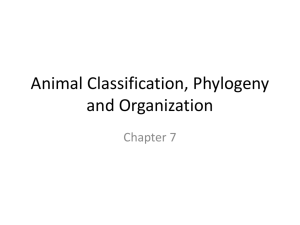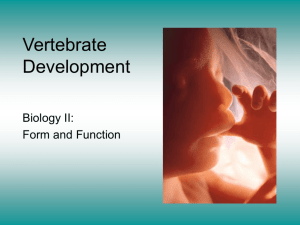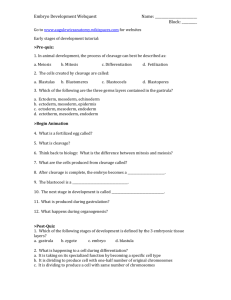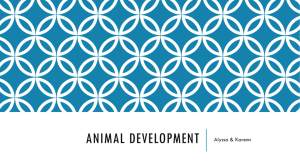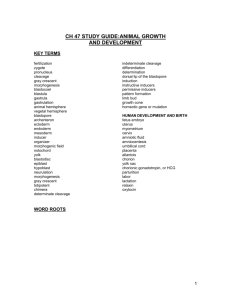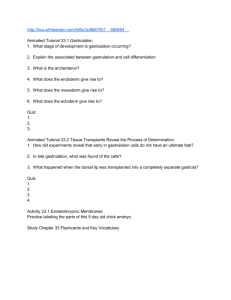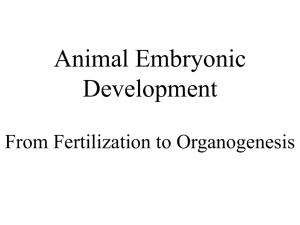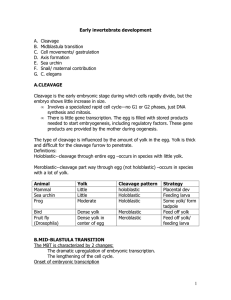Cell signals
advertisement
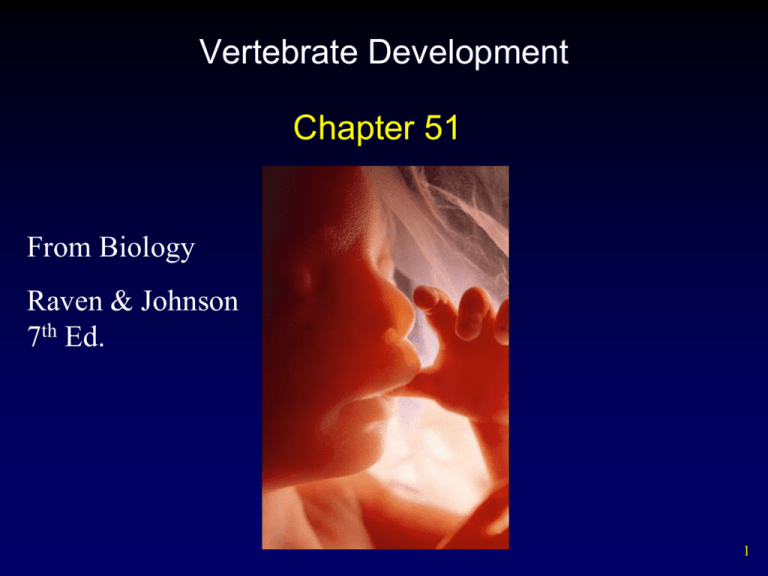
Vertebrate Development Chapter 51 From Biology Raven & Johnson 7th Ed. 1 Outline • • • • • • • • • Stages of Development Cell Cleavage Patterns (focus on mammalian) Gastrulation Developmental Process During Neurulation How Cells Communicate During Development Embryonic Development-Vertebrate Evolution Extraembryonic Membranes Human Trimesters Birth and Postnatal Development 2 Fertilization • • Penetration – glycoprotein-digesting enzymes in acrosome of sperm head Activation – events initiated by sperm penetration chromosomes in egg nucleus complete second meiotic division triggers movement of egg cytoplasm sharp increase in metabolic activity 3 Stages of Development • Nuclei fusion – The third stage of fertilization is fusion of the entering sperm nucleus with the haploid egg nucleus to form the diploid nucleus. 4 Cell Cleavage Patterns • Initial cell division, cleavage, is not accompanied by an increase in the overall size of the embryo. – morula - mass of 32 cells Each cell is a blastomere. eventually a blastula is formed 5 Terminology of Stages of Development ZYGOTE MORULA SOLID BALL EMBRYO BLASTULA (BLASTOCYST IN MAMMALS) GASTRULA 6 Cell Cleavage Patterns (only need to know yellow vocab here) • • Primitive chordates – holoblastic cleavage - egg contains little or no yolk, and cleavage occurs throughout the whole egg Amphibians and advanced fish – Eggs contain much more cytoplasmic yolk in one hemisphere than the other. large cells containing a lot of yolk at one pole, and a concentrated mass of small cells with very little yolk at the other pole. 7 Holoblastic Cleavage 8 Cell Cleavage Patterns • • Reptiles and birds – eggs composed almost entirely of yolk – cleavage only occurs in polar cytoplasm meroblastic cleavage Mammals – contain very little yolk – holoblastic cleavage – inner cell mass forms developing embryo – outer sphere, trophoblast, enters endometrium 9 Meroblastic Cleavage 10 Cell Cleavage Patterns • Blastula – Each cell is in contact with a different set of neighboring cells. Induction; ie: eye formation Cell signals (chemical messengers) regulate gene transcription in neighboring cells. 11 Gastrulation • Certain groups of cells invaginate and involute from the surface of the blastula during gastrulation. – By the end of gastrulation, embryonic cells have rearranged into three primary germ layers: ectoderm mesoderm endoderm 12 Gastrulation • Gastrulation in primitive chordates – surface of blastula invaginates into the blastocoel eventually inward-moving wall pushes up against the opposite side of the blastula produces embryo with two cell layers: outer ectoderm inner endoderm mesoderm forms later between the ectoderm and endoderm 13 Gastrulation in a Lancet (a non-vertebrate chordate) 14 Gastrulation • Gastrulation in reptiles, birds, mammals – no yolk separates two sides of embryo lower cell layer differentiates into endoderm and upper layer into ectoderm without cell movement 15 Mammalian Gastrulation 16 Developmental Processes During Neurulation • • Tissue differentiation begins with the formation of the notochord and the hollow dorsal nerve cord. – neurulation After the notochord has been laid down, ectodermal cells above the notochord invaginate, forming the neural groove down the long axis of the embryo. – edges move toward each other and fuse creating neural tube 17 Mammalian Neural Tube Formation 18 INDUCTION FORMATION OF THE EYE (pg 1093 Fig 51.16) • • • • • • 1. Optic vesicle grows from embryonic brain, which induces… 2. Lens vesicle forms from ectodermal cells, which induces… 3. Optic vesicle to round into optic cup (most of eyeball) **Induction is based on genes turning on. It is influenced by where the cell is (and what chemical messengers it contacts). 4. Lens vesicle separates from ectoderm 5. Inner layer of optic cup becomes retina 6. Lens becomes transparent 19 Developmental Processes During Neurulation • On either side of the developing notochord, segmented blocks of mesoderm tissue called somites form (segmentation). – Ultimately, somites give rise to muscles, vertebrae, and connective tissues. Mesoderm in the head region remains connected as somitomeres and form striated muscles of the face, jaws, and throat. 20 How Cells Communicate During Development • • Nature of development decisions – Some cells become determined early in development. – At some stage, every cell’s fate becomes fixed (commitment). not irreversible, but rarely reverses under normal conditions How is this related to stem cell research (embryonic/ adult stem cells)? 21 Copyri ght © The McGraw-Hil l Com panies, Inc. Permission required for reproducti on or di splay. Fig 51.17 Chordates Vertebrates Zygote Lining of respiratory tract Pharynx Endoderm Lining of digestive tract Brain,spinal cord,spinal nerves Blastula Gastrula Ectoderm Dorsal nerve cord Neural crest Gill arches, Epidermis, skin, sensory Major hair, epithelium, ganglia, glands inner ear, lens Schwann Liver of eye Pancreas cells,adrenal Mesoderm Notochord medulla Outer covering Circulatory Integuof internal Heart system ments organs Vessels Blood Lining of Skeleton Gonads Somites thoracic and Segmented abdominal muscles Kidney cavities Dermis 22 • Go to Active Board Interactive 23 Embryonic Development - Vertebrate Evolution • Ontogeny recapitulates phylogeny – Embryological development (ontogeny) involves the same progression of changes that have occurred during evolution (phylogeny). 24 Vertebrate Embryonic Development 25 Extraembryonic Membranes • Fluid-filled amniotic membrane an adaptation to terrestrial life – amniotic membrane an extraembryonic membrane Extraembryonic membranes, later to become fetal membranes, include the amnion, chorion, yolk sac, and allantois. 26 Extraembryonic Membranes 27 First Trimester • First trimester – fourth week - organ development organogenesis most women not yet aware of pregnancy Fetal Alcohol Syndrome 28 First Trimester • • Second month - morphogenesis – limbs assume adult shape – major organs become evident – embryo is about one inch in length Third month - completion of development – now referred to as fetus nervous system and sense organs develop all major organs established 29 Second and Third Trimesters • • Second trimester - growth – bone formation occurs – covered with fine hair (lanugo) – by the end of the sixth month, baby is one foot in length Third trimester - pace of growth accelerates – weight of fetus more than doubles – most major nerve tracts formed within brain – by end, fetus is able to survive on own 30 Birth and Postnatal Development • Uterus releases prostaglandins – begin uterine contractions, but then sensory feedback (positive) from the uterus stimulates the release of oxytocin from the mother’s pituitary gland rate of contraction increases to one contraction every two or three minutes strong contractions, aided by the mother’s pushing, expels the fetus 31 Birth and Postnatal Development • Nursing – Milk production, lactation, occurs in the alveoli of mammary glands when they are stimulated by prolactin. – milk secreted in alveolar ducts which are surrounded by smooth muscle and lead to the nipple first milk produced after birth called colostrum - rich in maternal antibodies Milk synthesis begins about three days following birth. 32 Birth and Postnatal Development • Postnatal development – Babies typically double their birth weight within a few months. – Neuron production occurs for six months. – allometric growth 33 Summary • • • • • • • • • Stages of Development Cell Cleavage Patterns Gastrulation Developmental Process During Neurulation How Cells Communicate During Development Embryonic Development-Vertebrate Evolution Extraembryonic Membranes Human Trimesters Birth and Postnatal Development 34 35
